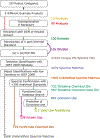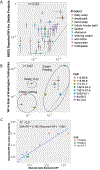Suspect Screening Analysis of Chemicals in Consumer Products
- PMID: 29405058
- PMCID: PMC6168952
- DOI: 10.1021/acs.est.7b04781
Suspect Screening Analysis of Chemicals in Consumer Products
Abstract
A two-dimensional gas chromatography-time-of-flight/mass spectrometry (GC×GC-TOF/MS) suspect screening analysis method was used to rapidly characterize chemicals in 100 consumer products-which included formulations (e.g., shampoos, paints), articles (e.g., upholsteries, shower curtains), and foods (cereals)-and therefore supports broader efforts to prioritize chemicals based on potential human health risks. Analyses yielded 4270 unique chemical signatures across the products, with 1602 signatures tentatively identified using the National Institute of Standards and Technology 2008 spectral database. Chemical standards confirmed the presence of 119 compounds. Of the 1602 tentatively identified chemicals, 1404 were not present in a public database of known consumer product chemicals. Reported data and model predictions of chemical functional use were applied to evaluate the tentative chemical identifications. Estimated chemical concentrations were compared to manufacturer-reported values and other measured data. Chemical presence and concentration data can now be used to improve estimates of chemical exposure, and refine estimates of risk posed to human health and the environment.
Figures





References
-
- Little JC; Weschler CJ; Nazaroff WW; Liu Z; Cohen Hubal EA, Rapid methods to estimate potential exposure to semivolatile organic compounds in the indoor environment. Environ. Sci. Technol 2012, 46 (20), 11171–11178. - PubMed
-
- Isaacs KK; Glen WG; Egeghy P; Goldsmith M-R; Smith L; Vallero D; Brooks R; Grulke CM; Özkaynak H, SHEDS-HT: an integrated probabilistic exposure model for prioritizing exposures to chemicals with near-field and dietary sources. Environ. Sci. Technol 2014, 48 (21), 12750–12759. - PubMed
-
- Wambaugh JF; Wang A; Dionisio KL; Frame A; Egeghy P; Judson R; Setzer RW, High throughput heuristics for prioritizing human exposure to environmental chemicals. Environ. Sci. Technol 2014, 48 (21), 12760–12767. - PubMed
-
- Rager JE; Strynar MJ; Liang S; McMahen RL; Richard AM; Grulke CM; Wambaugh JF; Isaacs KK; Judson R; Williams AJ; Sobus JR, Linking high resolution mass spectrometry data with exposure and toxicity forecasts to advance high-throughput environmental monitoring. Environ. Int 2016, 88, 269–280. - PubMed
Publication types
MeSH terms
Grants and funding
LinkOut - more resources
Full Text Sources
Other Literature Sources
Medical

